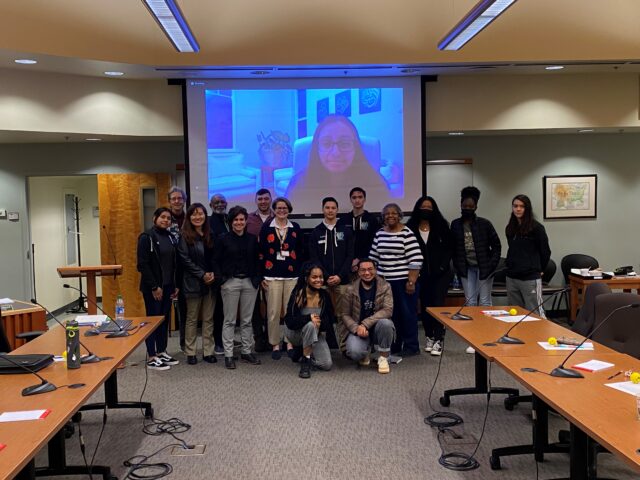The City is located on the traditional territories of the Coast Salish people, specifically the people of the Medicine Creek Treaty (1854), including the Nisqually Indian Tribe and the Squaxin Island Tribe. The City works with the Nisqually Indian Tribe and Squaxin Island Tribe in government-to-government partnerships.
On March 4, 2014, the Lacey City Council and the Nisqually Tribal Council participated in a ceremonial event to sign an historic agreement, The Nisqually Indian Tribe and City of Lacey Accord.The Accord acknowledges the partnership and mutual interests shared between the City and the Nisqually Indian Tribe. It also provides a framework for future meetings and collaboration. As a symbol of the partnership, the Tribe presented the Lacey City Council with a carved totem pole, which is currently displayed in the lobby of Lacey City Hall. A rededication ceremony occurred on July 9, 2015.
We acknowledge the ancestral land we are on today as the traditional territory of the Tribal People of the Treaty of Medicine Creek, signed in 1854, including the Nisqually Indian Tribe and Squaxin Island Tribe.
We acknowledge, remember, and must not forget those Tribal People that are named but not recognized today, and who were absorbed or relocated into other tribes for survival. We recognize the ancestors and their descendants who are still here.
We acknowledge, Indigenous People who called the land home before the arrival of settlers and have been here Since Time Immemorial.
We recognize the relationship that exists between Indigenous People and their traditional territories, which include the religious significance, self-determination, identity, and economic factors. The relationship helps all people heal from the past and learn how not to inflict new wounds today.
We recognize and respect Indigenous People as traditional stewards of this land, and acknowledge the Tribal Governments and their role today in taking care of these lands.
We recognize that this land acknowledgement, and the Nisqually-Lacey Accord of 2011, are small steps toward true allyship. We commit to partnering with the Tribal People of the Treaty of Medicine Creek to continue to uplift the voices, experience, and histories of indigenous people of this land and beyond.
We recognize and have the responsibility to call attention to the histories of dispossession, forced removal, and abridged treaty rights that allowed our nation, state, and city to develop as it has today. We recommend that community members read the Medicine Creek Treaty of 1854.
We [or insert object, e.g., “This Marker is”] are on the ancestral land of the Tribal People of the Treaty of Medicine Creek, including the Nisqually Indian Tribe and Squaxin Island Tribe. We acknowledge, and remember those Tribal People not recognized today who were absorbed or relocated into other tribes for survival. We recognize the ancestors and their descendants who are still here. We recognize and respect the Tribal People of the Treaty of Medicine Creek as the traditional stewards of this land since time immemorial and their role today in taking care of these lands in perpetuity. We recognize and have the responsibility to call attention to the histories of dispossession, forced removal, and abridged treaty rights that allowed our nation, state, and city to develop as it has today. We recommend that community members read the Medicine Creek Treaty of 1854.
The City of Lacey Land Acknowledgements may be used to:
- To open City meetings, events, or programming;
- As part of City plans, reports and other adopted documents; and
- On City signage, markers, maps, and other materials.
More information on Land Acknowledgements
Land Acknowledgements are formal statements that recognize, pay tribute to, express gratitude and respect for, affirms the ongoing relationship between indigenous people and the land, and helps raise awareness of the Indigenous histories, perspectives, and experiences —past, present, and future. Land Acknowledgments serve as one element of a broader effort to support Indigenous communities. These acknowledgements are statements recognizing the history and presence of Indigenous peoples and their enduring relationship to traditional homelands. Statements often call attention to treaty rights and historical injustices, while also honoring the modern culture and contributions of Indigenous people.
Land Acknowledgements are rooted in many Indigenous people’s practices and cultural protocols. As described on the Duwamish Tribe webpage:
“It is important to note that this kind of acknowledgement is not a new practice developed by colonial institutions. Land acknowledgement is a traditional custom dating back centuries for many Native communities and nations. For non-Indigenous communities, land acknowledgement is a powerful way of showing respect and honoring the Indigenous Peoples of the land on which we work and live. Acknowledgement is a simple way of resisting the erasure of Indigenous histories and working towards honoring and inviting the truth…”
Duwamish Tribe Webpage
The purpose of Land Acknowledgements are commonly to:
- Recognize and respect Indigenous communities;
- Provide support for Indigenous communities;
- Continue to build strong and authentic relationships with Indigenous communities;
- Bring awareness of histories that led to past and current development of an area, including history of dispossession, displacement, colonialization, cultural erasure, broken treaties, etc.;
- Recognize Indigenous history, culture, and positive impacts on the greater community; and
- Used as a step to inspire more action and better relationships.
- Importantly, land acknowledgements are not to be performative acts.









